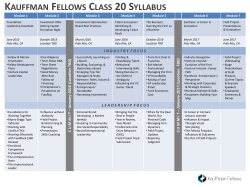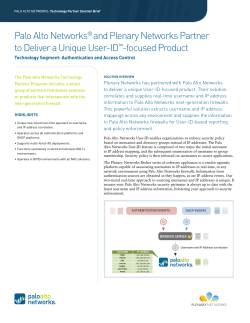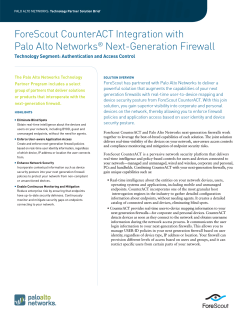
Document 284093
IR JOHN IARMINGTO~ SAMPLE ELECTRONICS -VIC- PTY. LTD. 9-11 CREMORN& STREET RICHMOND E. 1 VICTORIA. AU9TRALIA Four HP Women A Trip to Bermuda www.HPARCHIVE.com from the chairman's desk D ECENTLY there has been considerable publicity about cutbacks in military procurement programs and the effect of these cutbacks on defense-related industries_ As I mentioned in the June issue of Measure, several companies in our industry have suffered sharp reductions in sales and earnings, and some have had to layoff large numbers of employees and curtail expenditures for new plants and equipment. Fortunately our company, though a large share of its market is defense oriented, has maintained a steady increase in sales and profits, and we are basically optimistic about our future growth. At the same time, we are fully aware that the slowdown in defense expenditures poses some real challenges for us. It means that we will face keener competition all across the board and will have to work harder to maintain our share of existing markets for our products_ It also means that we will have to broaden and diversify our product line, thereby opening up new markets and becoming less dependent upon defense-related business. Developing new types of products and creating new markets is not something that can be done overnight. It requires the most careful analysis and planning, followed by extensive engineering effort. As you know, most of our products are at least a year in the design and development stage and some considerably longer. Obviously, the engineering task becomes even more formidable when we are considering entirely new types of instruments to be sold to entirely new markets. Ievertheless, there is certainly no reason why our present technology cannot be extended to new fields of measurement, and we are taking positive steps in this direction. The acquisition of Mechrolab last March has given us a scientific and marketing entry into the field of precision chemical analysis. This is a rapidly growing area and one making increasing use of electronic techniques. Among Mechrolab's more important products are osmometers, viscometers, and spectrometers. R Throughout the corporation we have several projects under way that will extend our measurement capabilities into new fields. Some of these projects are in the research and investigative stage; others have already generated specific product developments. In the medical field we are investigating new techniques of electronic anesthesia and improved methods of blood and urinalysis. Also under study are improved diagnostic techniques that probe the body with various kinds of electrically generated signals. We are active in microwave spectroscopy, a technique for detecting and measuring the different compounds in gaseous mixtures. We are investigating specialized areas of computer technology, particularly those involved with the display and processing of data acquired from electronic measurements. Our new magnetic tape transport is expected to be the forerunner of several interesting products in the industrial and medical recording field. We have a special group in Palo Alto investigating crystal technology and the application of various laser devices. Another group is studying the possible modification of many of our instruments to make them adaptable to nuclear measurement. While these are by no means all of the projects under way throughout the corporation, they represent some of our more significant efforts to expand our capabilities and markets. In many cases these efforts are in areas of vast market potential, running into many millions of dollars annually. In considering possible fields in which our technology may be successfully applied, we are interested only in those fields in which we can make a real contribution. We have no intention of producing instruments or systems that are no better than existing products. They must represent a significant advance in measurement technology, and have a good sales and profit potential. We are confident that many of the products currently under development in our laboratories will fulfill both requirements, and will contribute significantly to our future growth. www.HPARCHIVE.com What a way to go • • • to Bermuda! A Yewell engineer provided service on the high seas to aid important oceanographic project -. W ITH TOOTHBRUSH in hand, Dick Perry strode up the gangway of Atlantis II and paused momentarily on the quarterdeck to survey the scene of his next assignment. If he felt like James Bond, Agent 007, about to embark on a new caper, it was because his situation bore all the earmarks of good fiction. Earlier in the day, June 24, Dick had received an urgent call from the Oceanographic Institute at Woods Hole, Ma~s., requesting help on a new Dymec 2010J digital data acquisition system installed aboard its research vessel. The Yewell Sales Division field engineer responded promptly, only to find that the "trouble" was not in the equipment. It simply wasn't being operated to its best advantage and there was no time to properly indoctrinate the operators. The ship was due to cast off early the following day on a data-gathering voyage which would terminate in Bermuda. The members of the research team aboard the ship huddled and quickly decided that the only solution was to take the expert along with them. Perry did not have to be shanghaied. A free trip to Bermuda sounded just great-the next best thing to a vacation with pay. He sped home in his 1937 modified Bentley, packed his ditty bag, kissed his more-thanslightly startled wife, and returned to the ship. The following day, Atlantis II, a 210-foot steam-powered vessel specially designed for oceanographic research, headed out to sea with 30 scientists, a crew of 20, and HP's Dick Perry. He soon found that it was anything but a holiday cruise. The Dymec system under his command was used to collect water temperature data from 51 thermistors mounted along a 500-foot cable leading from the ship deep into the ocean. Some 24,000 readings each hour were taken. The ship's personnel followed an around-the-clock, three-watch system, but life for Perry was not so predictable. Since he was the most qualified electronics expert aboard, he found himself on call during all the watches to solve problems with the electronic gear on the heavily laden ship. (Some of this equipment may have been provided by HP competitors, but that's not for publication. ) When he arrived at Bermuda, Dick was nearly arrested by customs officers for "jumping ship," but he was finally able to convince them that his mission was accomplished and he had to catch a plane in three hours to fly back to the States. Some paid vacation! Top: Atlantis II leaves Woods Hole for the open Atlantic. Left: Perry poses aboard Oceanographic Institute's research ship. Right: Dymec system collected temperature data during Bermuda voyage. 3 www.HPARCHIVE.com VALUE has always been a most used and respected word in the Hewlett-Packard vocabulary. Earlier this year, when it came time to plan for the Western Electronic Show and Convention in Los Angeles, the theme "Focus on Value" was proposed by the marketing people for HP exhibits, and everyone agrees it's appropriate. To tangibly demonstrate what the theme means, the HP companies' consolidated exhibits are presenting some 50 new instruments and systems at the August 25-28 show. Among this raft of new products are several new Moseley recorders, an air traffic control test set from Boonton, a new voltmeter HP's '64 Wescon exhibits focus on value Because of its design excellence, Sanborn's new "500 Viso-Cardiette" is one of 19 products selected for exhibition in Los Angeles by the Wescon Industrial Design Awards Committee. The compact electrocardiograph was one of 132 entries in this competition. from Loveland, magnetic tape recorder systems by Sanborn, three new high voltage power supplies from Harrison, Dymec data plotting systems, the HP spectrum analyzer, cesium beam standard, and some unique new plug-ins for the 175A scope. The Hewlett-Packard display area at the Los Angeles Sports Arena extends 180 frontage feet near the center of the main floor. All divisions and affiliated companies are represented here, with the exception of HP Associates, which has an exhibit at Hollywood Park. Because of Wescon's growth, the '64 show with its 850 exhibitors has spread to two locations. The Sports Arena includes companies involved in instrumentation and systems. Exhibitors at Hollywood Park, 12 miles away, are primarily featuring electronic components. In 1965, Wescon will be held at the Cow Palace in San Francisco and during the following year it will return to Los Angeles where it will be held under one roof at the vast new L.A. convention center now being built. This year's show at Los Angeles is expected to attract a total of 45,000 visitors. 4 www.HPARCHIVE.com Four H P Women: COUNTERPARTS AROUND THE WORLD S HAKESPEARE will never live down the fact that he said, "Frailty, thy name is woman." Twentieth-century woman has proved that she is anything but frail and that she is completely capable of living in a "man's world." In fact, she has pretty well invaded every field of human endeavor with notable success, thus proving that the world outside the home is big enough for the two sexes, after all. Most men have gotten used to the idea and like it just fine. Take, for example, the four Hewlett-Packard women featured on the following two pages. Since each is from a different country, they have never known each other. And yet they have remarkable similarities in their lives on and off the job. These four women-in a sense counterparts-are all involved in product manufacturing. ot so long ago, men manufactured things and women had babies and kept house. Then it was discovered that women had other talents and could also manufacture things, often with consummate skill. Hewlett-Packard has always been aware of this fact and that is why, from the very beginning, women have figured importantly in the well-being of the company-not just in office work, but also in the plants and laboratories. The first HP woman was hired as a secretary in 1939, just a few months after the founding of the company. Today, more than 2,600 women (37 percent of the total employment) work for the parent corporation and all its divisions and subsidiaries. The jobs they hold range from assemblers, secretaries, nurses, and clerks to supervisors, accountants, and administrators. A large percentage of HP women are married, have children, and maintain well-managed homes. Their jobs enable them to improve their standard of living. But, surprisingly enough, many of them say that money is only a secondary reason for working. Mainly they like the "outlet," the opportunity to be with people, to work in pleasant surroundings, to do something constructive away from home. Whatever their reason for working, they are a vital resource of the company with their fine skills, their dependability, their warmth, and their intelligence. Rita, Inge, Kiyoko, and Judy-shown in that order at right and on the next two pages-are representative of HP women throughout the world. Unquestionably they are individuals with individual likes and dislikes. But their common bond is their important contribution to their company. 5 www.HPARCHIVE.com Four HP women (continued) England RITA ROUSE is a technical assistant at Bedford, England, the town where she was born a scant 19 years ago. She presently lives with her parents in the lovely home shown at left, where she is seen during a moment of repose. As the book on her lap indicates, reading is one of her favored pastimes-also needlework and piano playing. Along more athletic lines she enjoys tennis, and she is a member of the Girls' Life Brigade. Rita joined HP Ltd. four months ago in the signal generator test department, after graduation from the Silver Jubilee Secondary Modern Girls School. She is engaged to Malcolm Hare, an apprentice draftsman. Germany INGE PFEIFFER and her husband, Hilmar, organized a dance band in 1960. The initials of her husband, which appeared on the bandstand, now seem prophetic to Inge when she sees the picture above. Three years later she joined another HP at Boeblingen, where she serves as an assembler. Music has always played an important part in Inge's life. After having studied music in what is now East Germany, she was forced to leave Schumberg, her hometown, when the Communists took over political control. Moving to Weimar, she resumed her musical studies and sang light opera on radio, then switched to singing with a dance band, where she met her husband-to·be. Later, the couple formed their own band before Inge joined GmbH. The PfeifIers have two daughters-Karin and Brigitte. 6 www.HPARCHIVE.com Japan KIYOKO SUZUKI is a pert, fun-loving IS-year-old who likes to play softball with Yokogawa-HewlettPackard employees at the Tokyo plant recreation center. She does have quieter moments, though, when she practices flower arranging at home and plays the organ. She lives in Tokyo with her parents, three sisters, and a brother. Since joining YHP January 1 of this year, she has worked on an assembly line wiring instruments. Soon she, along with 250 other YHP employees, will be moving into their new building at suburban Hachioji-shi. Kiyoko is finishing high school this year by attending evening classes. U.S.A. JUDY NIEMCZYK, who graces Measure's cover, is, in many ways, symbolic of the HP working girl and Twentieth-century woman. She is completely feminine, an expert in the many skills of homemaking, an outstanding employee of her company, and an avid participant in a great variety of outdoor sports. Judy shares an apartment with another HP employee, Pauline Saurey, in Loveland, Colo. Judy joined the HP division there two years ago at the age of 21. A previous job as a seamstress helped develop a dexterity which serves her well in her wiring job at the plant. She says her goal in life is to get married, have a large family (preferably six children), and have her home in the Rocky Mountain foothills. 7 www.HPARCHIVE.com around the circuil By T NOEL E. PORTER, HINGS CONTINUE to move along at a good clip. We chalked up another strong performance in July, with corporate-wide orders topping $12 million and ship· ments exceeding $11 million. Our traditional business pattern calls for a slump in August, but thus far orders are maintaining reasonably good levels. All in all, we're optimistic about our fourth quarter prospects and expect to wind up the year with sales and profits considerably ahead of 1963. Here in Palo Alto we're bursting at the seams. While there is no critical need for additional instrument manufacturing capacity, we do need space for some of our engineering and advanced research activities, for our expanding Western customer service center, for consolidating our warehousing and materials handling functions, and for providing a new home for Paeco so HP Associates will have some additional elbow room in the building it's been sharing with Paeco. To this end, we are completing final plans and a detailed layout for the fifth building in our Stanford complex. With the addition of another underground warehouse, the total project will add about 170,000 square feet to our headquarters facility. A major benefit of this program will be the opportunity to consolidate our warehousing operations in the Palo Alto area. This will effect considerable savings by reducing our handling costs and eliminating presently rented storage space. As recently announced in the press, we intend to start con· struction this fall and complete the project within a year. In the meantime we'll have to do a lot of squeezing to make the best of the available Palo Alto space. Speaking of expansion, the Moseley people have just moved into their new plant addition in Pasadena. The move was accomplished over a weekend, so they were all set up for business the following Monday morning. Moseley's order level continues to hold up well, and the firm's new management team is sparking an aggressive new product program. Francis Moseley himself is developing some very exciting devices which will soon be ready for production. Sanborn continues to make good progress with all hands "turning to" in an effort to bring the division up to satisfactory performance levels. Orders were strong during June and July, production was also good, and they now have a reasonable backlog to work against. Sanborn's systems of production control, inventory control, order processing, and general administrative paperwork are being revised along the lines of general HP methods and standards. At Boonton, the necessary outfitting has been completed for the Eastern customer service center and this important Vice President, Operations new unit is moved in and operating. Nearby, Harrison Labs is well settled in its new facility. The Oscilloscope Division's new plant in Colorado Springs is receiving its finishing touches, with some production areas and the cathode ray tube facility still to be completed. On the fast.moving international front, we're continuing to strengthen our manufacturing and marketing capability. To keep pace with the increasing volume of European busi· ness, HPSA in Geneva is planning a new and expanded order processing system similar to the one we are adopting in the U.S. GmbH in Boeblingen is now manufacturing 61 HP family instruments and will soon be moving into its new plant addition. The subsidiary's volume is up 24 percent over last year. Over in England, HP Ltd. is producing some 40 instruments in the HP line and its volume is running 98 percent ahead of last year. Both GmbH and Ltd. are also making good prog· ress on their own new product programs. Y·HP in Tokyo is expected to move into its new plant in October. This joint venture company is now manufacturing 13 HP instruments and is taking on additional products at a good rate. As you can see, the total corporate picture is one of growth and expansion-a healthy sign if we are to keep HP on top of the instrument field. 8 www.HPARCHIVE.com Special issue will hail Hp·s twenty-fifth year Your next issue of Measure, planned for distribution on October 1, will be a special souvenir edition paying tribute to Hewlett-Packard Company's twenty·fifth birthday. The illustrated articles will describe this broad-based, world·wide company as it exists today ... will take a look at the promises of tomorrow ... and will trace the events through the years which have made it all possible. We think it will be a booklet you will want to keep and perhaps show your friends. Because of the extensive editorial research involved in such an undertaking, the next regular issue of Measure has been rescheduled for early November. Product design engineer Ted Pichel shows how new push buttons light up on a frequency synthesizer. 1 ~/.:. ~-"::"'-i·/~ < • The magic button S PEAKI G OF necessity and motherhood," said Vic Van Duzer, "what we need is a pushbutton that will light up without a bulb and it's got to be inexpensive and reliable." Ted Pichel, standing with Vic in front of Frequency & Time division's prototype frequency synthesizer, said he couldn't agree more. Before them on the synthesizer panel were the 103 buttons with 10 pushed in. Neither Van Duzer, synthesizer section manager at Palo Alto, nor Pichel, F&T product design engineer, thought it was easy enough to locate the 10 pushed buttons in a hurry. So they decided to build a better mousetrap. First they did considerable research into the subject. Commercially available illuminated buttons had to be dismissed as a possibility because they are relatively complex and too expensive. Each button must have a light bulb and a set of contacts to light the bulb. Back at the drawing board, Pichel sketched an idea which turned out to be beautifully simple, like most good ideas. It involves a button with a translucent numeral at the top. Beneath the button in a stationary position is a piece of Auorescent paper. When you push the button, the numeral is pressed against the paper and lights up. No bulbs to burn out. To complex mechanism. Hopefully. no great problem to manufacture. The Stanford plant Model Shop put the idea through the acid test by building several prototype buttons, and they all worked the way Pichel theorized and Van Duzer hoped they would. Then the team really went into action. The industrial designers came up with an esthetically pleasing shape for the buttons. Tool designers made material recommendations and designed the molds. The Photo Lab did the precision "step and repeat" work for numerals which were later to be accu< Don Pahl compares prototype parts of the buttons to original drawings. •• Elaine Van Noort demonstrates how simplicity of design eases the job of assembly. Over 3,000 buttons are being produced monthly for HP instruments and customers. rately punched in the Machine Shop. Men in the Sheet Metal Shop put on dark glasses and punched out the blinding fluorescent pellets. And so the buttons became a production item. At present, the F&T division is assembling over 3,000 of these new buttons monthly for HP instruments and for a few outside customers. Patent applications have been filed here and in five foreign countries, and several manufacturers have been licensed to produce them. As a crowning touch, HP's magic button won a merit award last month in the design contest sponsored by the National Electronic Packaging Conference. 9 www.HPARCHIVE.com Marketing Highlights: patterns of growth HEWLETT-PACKARD'S dynamic marketing organization continues to move forward in all areas of its activities. Top news in recent weeks centers about new locations for Horman and the HP Harrisburg offices, a new name for the Stiles Sales Division, a sales seminar in Palo Alto, and a new HP service center in the East. Horman Moves The Horman Sales Division's Baltimore branch has just completed its move into new quarters just west of Baltimore City at 6660 Security Blvd. The seven people there have 2,000 square feet of floor space in a modern, air-conditioned building, well situated from the standpoint of customers served. The branch was formerly located at 3006 West Cold Springs Lane in Baltimore. New Office at Middletown In mid-August, Earl Davis (Contract Marketing Division) moved his Harrisburg office to Middletown, Pa., where it is closer to major government customers. Now located in Olmsted Plaza, the branch has 1,100 square feet of office and storage space for the four-member staff. This office is primarily concerned with government business, and nearby Olmsted Air Force Base is a major customer. Others include the Frankford Arsenal, the Signal Corps, and Fort Monmouth. Commercial sales in this area are handled by the Robinson Sales Division. New Name for Stiles The Stiles Sales Division officially changed its name this month to the Florida Sales Division. The change is intended to more clearly identify and designate the division's area of responsibility, and at the same time add some additional emphasis to the Hewlett-Packard name in the eyes of the customers. Florida Sales Division, headed by division manager Gene Stiles, has 17 employees and offices in Orlando and St. Petersburg. National Sales Seminar The semi-annual field sales seminar was held in Palo Alto the week of July 13, and these conferences are getting bigger and better all the time. Some 85 field engineers from a score of HP sales divisions and affiliates attended, including personnel from Canada, Germany, Switzerland, and the Benelux countries. Dave Packard, Bill Hewlett, and Noel Eldred started the five-day seminar with brief talks. Panel discussions and talks by other corporate department heads rounded out the first morning. During the rest of the week the field engineers attended divisional briefing sessions and spent "free periods" discussing individual sales and service problems with division representatives. The "other half" of the field sales force-having attended a similar seminar in January-stayed home and tended the store. Eastern Service Center Opens HP's new Eastern Service Center, located at the Boonton Radio division facility in Rockaway, J., opened its doors August 17 to serve as a companion to the Western Service Center in Palo Alto. The new Center provides parts, accessories, operating supplies, and factory repair and calibration service, backing up HP's midwest and eastern sales divisions. Al Thoburn will manage the Eastern Center. The Western Service Center, managed by Chuck Ernst, provides similar services for the Neely, Lahana, and Southwest Sales divisions, and ARVA, Inc. Dymec has its biggest quarter in history Shipment of this system capped a record-breaking July at Dymec. On hand for the occasion were (from left) Ed Percy, Chuck Quanz, Richard Phillips, Paul Powell, Dave Stead, George Weiland, and Lee Staufenbiel. 10 www.HPARCHIVE.com WHEN THE FINAL figures were tabulated at the end of July, the ear-to-ear smile was standard expression throughout the Dymec organization. The month had produced $1 million in orders, bringing the total for the quarter to over $3 million. This is nearly $1 million above the comparable quarter in 1963. New sales records were set for 2010 data acquisition systems, 2401B integrating digital voltmeters, 2460 amplifiers, and 2590A microwave frequency converters. Contributing heavily to the figures, the Neely Sales Division brought in over $1 million in orders during the three months. A new shipping record was also set in July, which exceeded the best previous month by $200,000. In addition, the Dymec engineering model shop and manufacturing's wire, assembly, and test groups set all-time production records during the month. people on the move COLORADO SPRINGS From Oscilloscope Division, Palo Alto, to Colorado Springs: A ndi A rti, industrial design; Allen Best, design engineer; George Blinn, product design; Nick Broderick, manager CRT manufacturing; Lynn Chase, service engineer; Dick Cline, sales manager; Don Corson, sales engineer; John Deans, applications engineer; Bob Deitz, process engineer; John Foucault, screening; George Koutures, process engineering; Ed Lauffenburger, publications illustrator; Lee Moffitt, design engineering; Fred Rianda, special handling; John Richter, contract adminis· trator; Cort Van Rensselaer, general manager. Norm Hall, publications manager; Darwin Howard, section manager; Al Knack, tech· nician; Byron Low, CRT tool engineer; Milton Russell, CRT engineer; Allen Smith, manufacturing specifications; Gerald Wilson, CRT prod uction; Blair Muhlestein, tool engineering, Microwave Division to tool engineering. EASTERN SERVICE CENTER From Customer Service, Palo Alto, to Eastern Service Center, Rockaway, N.J. Jerry Bender, technical advisor; Jack Carlozzi, senior test engineer; Lionel Coates, supervisor inventory control; Dick Love, supervi. sor parts management; AI Thoburn, manager. YEWELL ASSOCIATES From Sanborn Medical sales to Yewell Associates, Burlington, Mass.: Bruce Blomster, medical sales; Dan Cleveland, medical sales; Bob DeSimone, medical service technician; Ed McDonald, medical sales; Mike Petricone, medical sales manager; anny Rezendes, medical sales; Don Taylor, medical staff; Fred Andrews, medical sales (Middletown, Conn. office). YOKOGAWA·HP Jerry Worth, International Operations staff to staff advisor to president, Yokogawaewlett·Packard. DYMEC LAHANA Kress Alexander, tool engineering, Oscilloscope Division-to tool designer, Dymec. Bob Cornell, production section manager, F&T Division-to production manager, Dymec. Frank Wheeler, manufacturing manager, Oscilloscope Division-to manufacturing manager, Dymec. Lou Carder, secondary standards lab, Martin, Denver-to customer service manager, Lahana &. Co. Dan Montgomery, Sperry, Utah-to clinical service and sales, Lahana & Co. Salt Lake City office. Bob Stringer, customer service manager-to staff engineer, Lahana & Co. SANBORN Frank Fairchild, as istant section head, in· ventory control, HP Palo Alto-to manager of inventory control and purchasing, Sanborn. Albert Baltazar, accountant-to manager of general accounting department, Sanborn. HP PALO ALTO Norm Bowers, tool engineering, Oscilloscope Division-to tool engineering, Frequency & Time Division. Jerry Carlson, Palo Alto accounting-to corporate Finance. Jim Chesebrough, engineering staff, Oscillo· scope Division-to Advanced R&D Physics staff. Cliff Edginton, order processing, corporate marketing staff-to supervisor, order processing, Frequency & Time Division. Bill Hawkins, special handling, Oscilloscope Division-to special handling, Frequency & Time Division. Bill Kruger, engineering staff, Oscilloscope Division-to Advanced R&D Physics staff. Vin LaCoste, technical assistant, corporate operations office-to advertising and sales promotion staff, corporate marketing. Lyle Loeser, CRT lab, Oscilloscope Division-to tool engineering, Frequency & Time Division. Leroy McClure, materials specifications-to electronic tooling, Frequency & Time Division. Karl Schwarz, manufacturing manager, Dymec Division-to section production manager, Frequency & Time Division. Charlie Shields, government order processing, customer service-to inventory control, materials management. Published monthly for the employees of Hewlett-Packard and its affiliated companies Vol. 2 Editorial Director Editor Associate Editor August 1964 No.8 DAVID KIRBY WILLIAM BIGLER MERLE MASS EWLETT-PACKARD COMPANY 01 Page Mill Road Palo Alto, California HP ASSOCIATES Bernie Coler, RF Associates, San Carlosto marketing staff, HP Associates. Milton Crane, research associate, Stanford University Electronics Lab-to applications group, HP Associates. Charles Forge, R&D staff, Oscilloscope Divi· sion-to applications group, HP Associates. SOUTHERN SALES DIVISION Carroll G. Moore, field engineer, Atlanta office-to senior engineer, Huntsville office. Leon W. Bissette, field engineer, High Point office-to senior engineer, Louisville office. Charles W. Ledford, service technician-to medical specialist, High Point office. John R. Hoard, Department of Ophthalmology, Louisville Iedical School, Kentucky-to staff engineer, Southern Sales, Louisville office. John B. Brennan, III, design engineer, Georgia Power Co., Atlanta-to staff engineer, Southern Sales, Atlanta office. Carl E. Osborne, Jr., R&D engineer, American Electric Mfg. Corp., Southaven, Mississippi-to staff engineer, Southern Sales, Huntsville office. James J. O'Brien, Medical field division, Sanborn to medical specialist, Southern Sales, Richmond office. LOVELAND Bill Kay, Advanced R&D, Palo Alto-to development engineer, Loveland. BOONTON Steve Jackman, customer service-to senior test engineer, Boonton. CONTRIBUTING EDITORS ANN ASH, Syracuse Sales Division GENE CLINE, Florida Sales Division DOROTHY CLINK, RMC Sales Division SHIRLEY COCHRAN, Colorado Springs DONNA COFFEY, Yewell Associates PATTI COOPER, Lahana & Company MONIQUE EMBOURG, HP Benelux (Brussels) ROSE HARMON, Harrison Laboratories FRED HARVEY, Crossley Associates DOUG HERDT, Hewlett-Packard SA HELEN HOBSON, Southwest Sales Division DAVE HOGAN, Mechrolab HANS HUBMANN, Hewlett·Packard VmbH CONNY KOEDAM, HP Benelux (Amsterdam) KATSUTO KOHTANI, Yokogawa-HP, ltd. BILL DALLENBACH, Dymec Division COLLEEN MOLINEU, Horman Associates DAVE PENNING, HP Associates JIM PHELPS, Sanborn Company JOHN RICCI, Boonton Radio BOB RUSSELL, Hewlett-Packard (Canada) ltd. WALT SKOWRON, Loveland Division LYMAN SWENDSON, F. l. Moseley Co. MIKE TALBERT, Neely Enterprises DENNIS TAYLOR, Hewlett-Packard ltd. VIRGINIA THORNTON, Southern Sales Division BARRIE WILMARTH, Robinson Sales Division HElKE WOLLRAB, Hewlett-Packard GmbH "I often say that when you can measure what you are speaking about, and express it in numbers, you know something about it; but when you can· not measure it, when you cannot express it in numbers, your knowledge is of a meager and unsatisfactory kind ..." LORD KELVIN (1824·1907) www.HPARCHIVE.com Sunday, July 26, was a day when two HP men made sports history. One man outran the Russians and another proved he was an unsurpassed sailor. UPI PHOTO ON THAT HOT JULY SUNDAY, the Russians blamed it on the smog, but Jeff Fishback, breathing the same air, was still able to beat them to the finish line in one of the toughest track events. The race was the 3,000meter steeplechase at the U.S.-Russian meet in Los Angeles, and Fishback placed second behind America's George Young, helping the U.S. gain an impressive victory. Fishback is a graduate student at San Jose State College and an HP summer employee. THE NATIONAL SAILING championship for El Toro boats now belongs to Norm Williams of the corporate personnel department. He completed his third day of racing competition at California's Huntington Lake, turning in the best score against the nation's finest El Toro skippers. HP Sailing Club members were not surprised. He has beaten them, too, 18 times in the last 23 starts. www.HPARCHIVE.com
© Copyright 2025





















